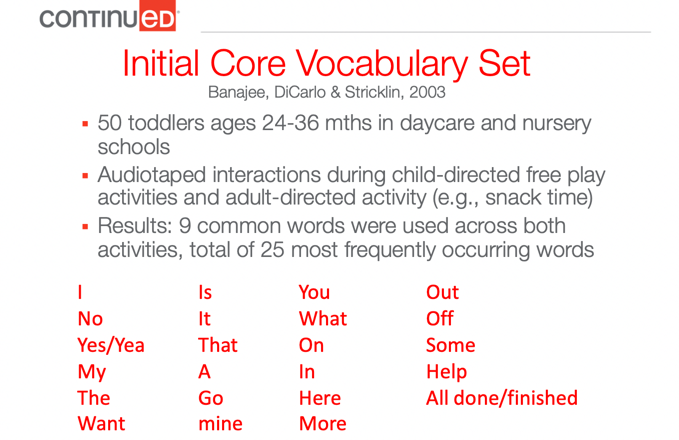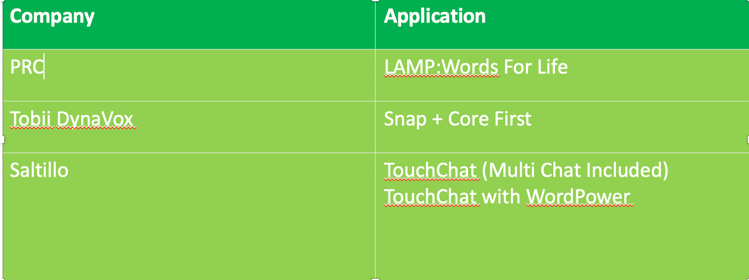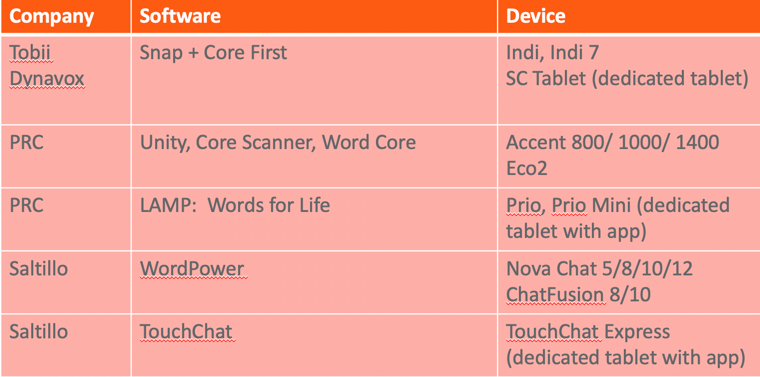Learning Objectives
After this course, readers will be able to:
- define vocabulary selection methods for AAC and explain the difference between core and fringe vocabulary.
- identify AAC systems and AAC apps that utilize core vocabulary.
- describe how to write goals that incorporate core vocabulary across competency areas.
- explain how to integrate and teach core vocabulary across activities, environments and communication partners.
Vocabulary Selection for AAC
Thank you for taking time out of your busy schedule to learn about vocabulary for individuals who use AAC. I find that thinking about vocabulary and choosing appropriate vocabulary for my AAC clients is very challenging. When you are the person responsible for choosing the words that an individual can use to communicate, that is a big responsibility that we need to think about. If you are the SLP that's making the communication display for a no-tech communication system or you are choosing the vocabulary page set that your client is going to be using on their AAC system, that's a big job to think about. It can be very challenging because we need to provide children with the vocabulary that they need to address multiple and increasingly demanding needs which include:
- Interacting socially with family and friends and their peers
- Participating in their classroom and their educational environment and having enough appropriate vocabulary to do that
- Vocabulary that encourages the development of both language and literacy skills
- Vocabulary that helps them achieve academically and participate in those academic environments
Vocabulary Selection Methods
Environmental
How do we choose vocabulary? There are different vocabulary selection methods that are discussed in the AAC literature. One of them is environmental vocabulary selection which is an approach that allows you to observe the client in different environments. For example, we can go into the child's classroom and take an inventory or list of appropriate words that they need to participate in the classroom. The list might be words that the students in the classroom are using or words used in response to questions that teachers are asking. We are going to jot those words down, make a list, and make sure that our client has access to them.
We can also get a list of words from parents if we want to make sure that they have appropriate words to communicate in their home setting. Back in the classroom, it may be a list of curriculum words that a teacher is using in their classroom throughout the year or throughout the quarter.
Developmental
Another method is a developmental approach. As SLPs we have knowledge of language development and we can use those resources to help determine what vocabulary to include on a child's AAC system. We first want to determine where the child is developmentally in regard to their language and cognitive level. Then, we match that with the words that they need at that level. That helps provide some direction of where to go in terms of what words to add to their list and what words they will need to expand their language.
Functional
The next vocabulary selection method is the functional approach. With this approach, we can look at what the most frequently used words and phrases are in a specific environment or with a specific age group. Typically, we use research-based word inventories and I will share those later so that you have that resource.
Types of Vocabulary
While we're thinking about the different kinds of vocabulary selection methods, we really need to be thinking about core vocabulary versus fringe vocabulary and which one should we be thinking about when we're choosing words to put on a communication system.
Core vocabulary refers to words or phrases that are commonly used by a variety of people. These are words that are used by peers and are used in multiple environments. When looking at parts of speech, these words do not include specific nouns. Rather, they are verbs, pronouns, descriptors, adverbs, and maybe even articles of speech. They are words that we can use no matter where we are and they're not related specifically to an environment or to an individual.
Fringe words are specific to the individual. It might include words that represent their interests, their family, or their job. Fringe words are specific to an environment or specific to an individual.
Core Vocabulary
Approximately 250-400 words make up 75-85% of the words we say. These are our core words. When we're thinking about the vocabulary that we want to choose to add to an individual's communication system, we want to use the words that individuals are using 75-85% of the time. Doesn’t it make the most sense to fill the communication board or think about a vocabulary set that consists of these words because we know an individual can use them across environments and across people with whom they are speaking.
Core vocabulary consists of words that are common to peers that are similar in age to them. It's really a relatively small set of vocabulary and doesn't change across environments or individuals. These words provide a framework for functional language.
When we think about these 250-400 words that are mainly of verbs, pronouns, descriptors, and adverbs, we can use them for a variety of functional purposes. We can combine the words in different ways to make requests, to answer questions, to ask questions, to comment, and to communicate socially. It gives us a nice foundation for a lot of functional language use. Also, because these are generic words, we can combine them in different ways to make a variety of novel utterances.
Again, when thinking about what words to use to fill up a child's communication display, we want to use words that they're using the majority of the time. So, it makes sense to consider core vocabulary when deciding what vocabulary to include on an AAC system. When designing the displays or evaluating different vocabulary sets that are within high-tech communication systems, use this rule of thumb: The ratio of core to non-core should be 4:1. Primarily, we are using core vocabulary for communication display but then integrating some non-core words or fringe words in order to customize it a bit. For example, if I'm making a communication display for myself, I'm going to include the name of my husband, my sons’ names, the activities that they do, things about my job, etc. because those fringe words are important to me and I'm going to use them all the time. However, your fringe words are going to be different than mine. But the rest of what I say - that 75-85% - is going to be the same words that you use. So, remember that ratio of 4:1 when designing displays.
Research-Based Words Lists
With an understanding of core vocabulary and why it's important, what are some resources that can help us decide which core vocabulary words to include. Fortunately, some research has been conducted to help us out. A research study done in 2003 by Benajee, DiCarlo and Stricklin looked at the vocabulary used by 50 toddlers in a daycare and nursery setting. Their hope was to develop a list of the most frequently occurring words toddlers are using in their daily environments and daily activities. They came up with a list of the 25 most frequently occurring words (Figure 1).

Figure 1. Initial core vocabulary set.
Notice that there are no specific nouns. There are some pronouns, verbs and descriptors. These are all core words. So, if I am working with a young child who's using AAC or a child who's just starting to use AAC, I can use this list as a guideline for words I want to teach first to my client.
Looking at the list, you might be thinking that there aren’t very good pictures for these words. It is tricky to represent these words on a communication display. Nouns are better pictures, right? If we think about an apple or a ball or a Goldfish cracker, we know what those pictures might look like and we can use those pictures on a communication display to easily represent those nouns. When we look at the words in the above list, how do we represent a word like, go? You might have a picture in your head that is a bit different than mine. One of the challenges about core words and why we get hung up on whether or not we're going to include them on an individual's communication display is because they are not good picture producers. But just like any kind of vocabulary, we have to teach that vocabulary to the children we're working with. They can learn these words even though they're not the best pictures. I will discuss more of that shortly.
There are other research studies. One is the Marvin Sampling which is a list of 333 most frequently occurring words in the preschool setting. Notice that only 50 of the 330 words were specific nouns and the other words were all core words. Again, emphasizing the fact that those are the words that children use the most often. If you're working with children in the preschool setting that could be a great resource to decide which words to add to the child’s communication display or which words to have on their high-tech system.
Another research study was conducted by Boenisch & Soto in 2015 and looked at an older population. They were interested in the top 100 words used by second, fourth, sixth and eighth-graders. Look at that breakdown, most of the words are verbs and pronouns with adverbs and prepositions coming in next:
- 26 verbs
- 17 pronouns
- 14 adverbs
- 9 prepositions
**all other parts of speech occurred 7 or fewer times.
Another resource that I've found to be helpful is for individuals who are trying to meet the Common Core Standards in the school setting. How do we look at vocabulary with respect to those Common Core Standards? The Dynamic Learning Maps (https://www.med.unc.edu/ahs/clds/resources/core-vocabulary/) provides a great resource to look at how core vocabulary lines up with the common core.
The word lists previously mentioned were based on an individual’s verbal output (i.e., what words they are using). There are also some research studies that look at writing samples because in writing we are taking language and moving it to the motor skill of writing. The thought is that writing might correlate with AAC because AAC takes language and puts it to a motor skill of touching a communication display by touching a screen or touching a communication board. Researchers want to consider the way individuals write and what words they’re using because it might mimic the words that an AAC user is using.
One particular study investigated written language of 2nd-6th grades (McGinnis & Beukelman, 1989). Again, there is a theme of core vocabulary occurring. We can identify some core words that are making up about 70% of what the students were writing. Most recently in 2013, Clendon, Sturm, and Cali looked at writing skills again. They specifically looked at kindergarten through 1st grade and found the same thing of 70% of the words written were core words (e.g., verbs, adjectives, adverbs, pronouns, articles, prepositions). They also studied the most frequently occurring phrases included:
I like I went to
Going to I am going
I am I like to
Went to am going to
This list is good to refer to when we start building sentences or conversation skills with our individuals who use AAC. These phrases can be taught first.
What Vocabulary is Available on AAC Systems?
When looking at different levels of AAC from no-tech to high-tech, what vocabulary is available? The vocabulary that is added to no-tech and low-tech systems is usually created specifically for the AAC user. For example, SLPs are choosing what words to put on a communication board that somebody's using. The SLP might be choosing specific words to add to a PECS book. We are in charge of that. We want to refer back to those evidence-based practice articles and see what words are being used the most.
There are some pre-designed no-tech systems that are available for purchase. I will discuss a couple of those shortly. When we move up to the mid-tech range, some of these are voice output devices. However, clinicians are usually making pages for those devices. Finally, when we move to high-tech or AAC apps that are available, there are a lot of pre-designed page sets that we can explore the best fit for an individual that we're evaluating or an individual that we're considering for use of AAC.
No/Low Tech Systems
Some available no or low-tech systems that are available for purchase, and there are many others, are the Pixon Project and the WordPower 60. The Pixon Project is a no-tech board available through the Prentke Romich website ( www.prentrom.com) and was developed by Bruce Baker and Gail Van Tatenhove who do a great deal of work in the field of AAC. Bruce Baker has conducted a lot of research on vocabulary and Gail Van Tatenhove has given many presentations and has many practical solutions for using core vocabulary with individuals.
Saltillo offers a free download - a paper version - of their high-tech dynamic display vocabulary page set of the WordPower 60. You can print those and make your own no-tech kind of dynamic board for individuals. They list core vocabulary on the main page so you don’t have to make them yourself. You can also use those words as a guideline to customize some of your clients' no-tech or low-tech systems.
I have highlighted a few communication apps, but this is definitely not a comprehensive list.

Figure 2. Communication apps.
Prentke Romich has LAMP Words for Life that's based on core vocabulary. Tobii DynaVox has their page set, Snap + Core First. Finally, Saltillo has an app called TouchChat and TouchChat with WordPower, which are all based on core vocabulary.
High Tech Systems
High tech systems that have core-based pages are listed in figure 3. Again, this is absolutely not a comprehensive list. These are the systems that I'm most comfortable with and know that they are based on core words and have good core page sets to choose from within their systems.

Figure 3. High tech software.
These examples provide some guidance for how to choose vocabulary or where to find systems or page sets that have core vocabulary.
Integrating Core Across Activities, Environments, and Communication Partners
How do we integrate core vocabulary across activities, environments and communication partners? Let's first think about writing goals. There is a lot to consider when writing goals for individuals who use AAC. One of those considerations is making sure to cover all four areas of communicative competence: operational, linguistic, social and strategic competencies.
Operational Competence
Operationally, we want individuals to operate their device and perform all of the operational features associated with that. With vocabulary, operationally, we want to make sure the individual can locate and navigate to those core words. So, if you're designing your own vocabulary page for an individual, put the core words where they're easily accessible so the client can find them quickly since they are going to be using those the most.

